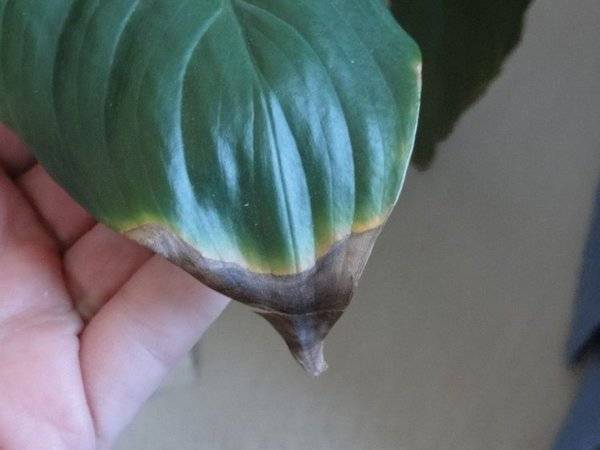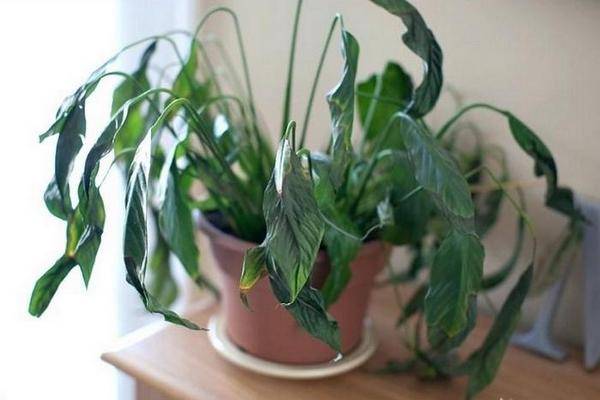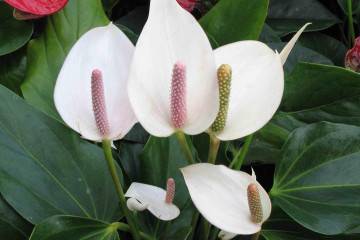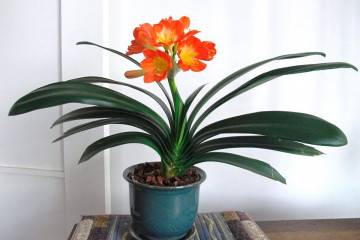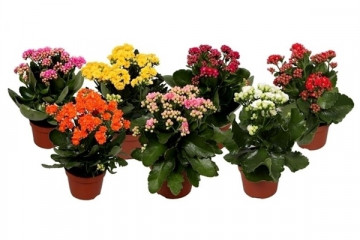Spathiphyllum - home care, why leaf tips dry
Content:
- Spathiphyllum content at home - demanding plant or not
- Spathiphyllum: leaves turn yellow, how to eliminate the cause
- Spathiphyllum: leaves turn black at the edges, what to do
- Spathiphyllum: home care, why leaf tips dry
- What causes the leaves of spathiphyllum to curl
- Why do the leaves of spathiphyllum turn pale
Spathiphyllum, or, as it is also called, female happiness, is referred to as spectacular and beautiful houseplants. It does not always please its caring mistress. If the rules of care are violated, the foliage may turn pale, become lethargic, and later turn yellow or black. Sometimes the leaf plates curl up, droop and dry completely. Florists know a lot of ways to resurrect spathiphyllum, return its original appearance.
Spathiphyllum content at home - demanding plant or not
Spathiphyllum is a member of the Aroid family, which includes about 45 species. In natural conditions, it can be found in the Philippine, Brazilian and Venezuelan territories.
Its genus includes perennials, the main difference of which is the absence of stems. Foliage begins to grow directly from the root system, it can be oval or lanceolate. Spathiphyllum blooms in spring days, the inflorescence is represented by an ear, covered with a kind of veil. After the end of the budding period, it is cut shortly.
Spathiphyllum gained popularity among flower growers due to its complete unpretentiousness and the absence of excessive requirements for courting. Decorative leaf plates played an important role in the spread of the flower. Despite the small requirements, it needs high humidity, abundant watering. This approach will allow him to develop and grow normally.
Spathiphyllum: leaves turn yellow, how to eliminate the cause
A change in color gamut can be observed in healthy specimens of yesterday. The problem quickly spreads to leaf plates and arises from many prerequisites. The general clinical picture in different lesions is similar, so the likelihood of an erroneous diagnosis is high. Ignoring the symptoms can lead to the death of spathiphyllum as soon as possible.
Florists distinguish between the following sources of pathology and offer separate therapy methods for each option:
- lack of attention during courtship. After active budding, spathiphyllum can get tired, it needs time to recuperate. The lower foliage on the bush will begin to actively turn pale, wither and wither. As first aid, transplanting into a larger pot with fresh soil and feeding with a special composition are used;
- wrong approach to lighting. Prolonged exposure to direct sunlight will damage the green part. Sunburns occur when there is no shading in hot weather;
- increased dryness of the air. Spathiphyllum does not tolerate the period of operation of central heating.The solution to the problem is to move the capacity away from the batteries, use a humidifier, and regularly spray. Some housewives prefer to put an aquarium or a container of liquid next to the flower.
Spathiphyllum: leaves turn black at the edges, what to do
A number of factors are attributed to the sources of the development of a non-standard appearance. Botanists advise first to understand the reason for the blackening of the leaf plates and only then take up the resuscitation of the affected specimen.
Why do the tips of all leaves turn black in spathiphyllum and how to save it:
- freezing of the root system. A tropical flower prefers to grow at a temperature of at least 15-18 ° C. The pot must be rearranged closer to the heat source, not forgetting about regular spraying;
- improperly selected soil. Spathiphyllum needs loose, easily air-permeable soil. A dense and caked substrate causes stagnation of moisture, provoking the development of rot in the root system. The consequence of decay is blackness on the green part;
- low air humidity. In the first weeks, yellowing and drying of the foliage is observed, a little later, its blackening. An exotic plant requires watering and spraying throughout the calendar year. The spathiphyllum will take a break as a drought and start getting rid of excess leaves;
- oversupply of fertilizers. Excess nutrients are no less destructive than their lack. To resolve the issue, you need to take a break of one and a half months, and then adhere to the dosages indicated by the manufacturer on the feed label;
- waterlogging. Occurs when the number of irrigations is incorrectly calculated. In the summer, the procedure is performed every 3-4 days, in the winter - less often. Before watering, you need to make sure that the top layer in the pot is dry enough;
- sunburn. Prolonged exposure to the sun leads to serious damage to the leaves of the spathiphyllum. The affected parts must be removed, and the container must be rearranged in partial shade until complete recovery.
Spathiphyllum: home care, why leaf tips dry
There are several versions of this anomaly. Experts advise finding the source of the problem and immediately treating spathiphyllum. The list of suggested factors includes:
- incorrect calculation of feeding. With an insufficient intake of minerals, a similar picture can be observed: the foliage will begin to dry out gradually. For therapy, a nitrogen-potassium-phosphorus mixture is used;
- water scarcity. Initially, the leaf plates brighten and become yellow, later they begin to dry. For a tropical plant that has lived in a maritime climate, dry air is very harmful. To compensate for insufficient moisture, the foliage should be regularly wiped with a cotton pad soaked in liquid, sprayed with a spray bottle. The pallet can be covered with pebbles, sand and expanded clay, and only then pour water into it and put it under the pot;
- excess moisture. Also leads to drying out of the tips of the foliage of the spathiphyllum. Excessive moisture, caked earth and the lack of a drainage layer provoke stagnant water. The root system begins to rot, and the leaf blades dry out.To solve the problem, take a double container, the space between the walls is laid out with wet peat or moss.
What causes the leaves of spathiphyllum to curl
Leaf blades begin to curl, and new ones begin to shrink if necessary changes in the mode of care: watering, lighting or nutrition. The sources of the problem include:
- reduced room temperature. The leaves acquire dark shades, up to a burgundy-green color. They begin to wrap themselves in a kind of cocoons. The deviation is caused by being in a place where drafts are constantly walking, or air from an air conditioner gets on the plant;
- lack of lighting. The problem is relevant during the winter months or during prolonged and prolonged rains. To correct the situation, a specialized UV lamp is used, it will help to make up for the lack of sunlight;
- defeat of aphids. The attack of the parasitic insect is suppressed by insecticides. Experienced flower growers prefer to use actellic, which gives the desired effect after the first procedure.
Why do the leaves of spathiphyllum turn pale
Blanching of the foliage signals a disturbance in the care of the spathiphyllum. Whiteness occurs in the early stages of the lesion, then yellowness, dark spots appear. The specimen is affected by rot, dries up and dies.
With the correct identification of the source of the disease and the timely implementation of resuscitation measures, the plant has a chance for recovery.
Common sources of the anomaly are presented below.
Increased dryness of the air
Spathiphyllum needs regular ventilation of the room, but subject to the absence of drafts. A stuffy room negatively affects its general condition, as does the proximity of central heating radiators. It is better to move it to a ventilated place, away from the heating system.
Improper watering - excessive or insufficient soil moisture
Stable overflows are a common root cause of discoloration of sheet plates. To check suspicions, it is enough to inspect the ground, it should be loose, soft and slightly moistened.
During transplanting, it is necessary to check for drainage holes in the new container. If they are absent, then the liquid will constantly stagnate, causing root rot, and the substrate will deteriorate.
Fungal infections
The culture is susceptible to fungal attack, often include rust and black spot. You can fight them only with fungicidal solutions. Therapy begins with the appearance of specks of a grayish, yellowish or brownish hue. In affected spathiphyllums, areas damaged by rot are cut off, the cut sites are treated with crushed charcoal or activated carbon and a solution of potassium permanganate. In the future, the flower needs to be transplanted into a new container with fresh soil.
The green part is treated with chemicals against fungal infections.During therapy, you can feed the flower with zircon, epin, which will help to raise the plant's immunity, strengthen its fight against infection, and revive it.
Parasitic insects
The primary destruction of pests is carried out by mechanical cleaning of the foliage using a soap solution and a cotton pad. In parallel, the outer sides of the pot, the window sill and the pallet are processed. The solution is left on the flower for 2 hours, then bathing in the shower is carried out.
With a massive defeat of spathiphyllum, this method will not be successful; it is necessary to destroy the parasites with insecticidal compositions. They are effective and fast; secondary processing is required after a week. After therapy, most flowers are successfully restored.
Exotic spathiphyllum has taken its rightful place in the homes of indoor flower lovers. In addition to its appearance, it has the ability to rid housing of benzene, formaldehyde and accumulated toxic substances. The plant is deservedly considered not only beautiful, but also useful.
When asked why the leaves of spathiphyllum turn yellow, you should not expect high-quality air purification. The green healer requires help from his owner, he will have to be reanimated. But if you take care of it correctly, then the leaves will not darken, become pale or yellow.




